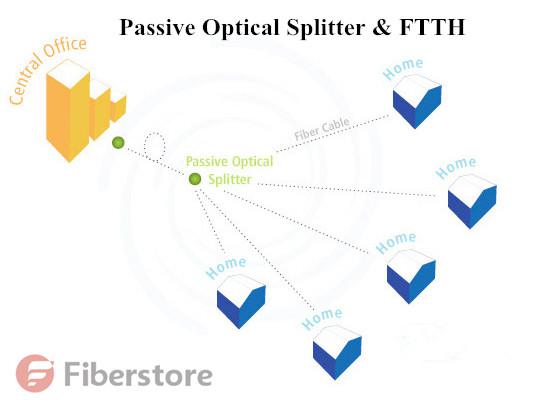Created by the Full Service Access Network (FSAN) working group, the Passive Optical Network (PON) is a group of technologies that put Fiber to the Home (FTTH) into reality. It consists of a central office node optical line terminal (OLT) at the service provider’s office and a number of optical network units (ONUs) near the end users. A single PON network interface can be shared among many subscribers through the use of PON splitter which contains no electronics and use no power.

For the FTTH network designer, one of the key parameters is the achievable span between the central office and the subscribers (the maximum optical budget allowed in the system). As a part of the optical budget, the PON splitter is the most demanding component in terms of losses. Thus every FTTH system vendor is advised to use a PON splitter with the lowest level of insertion loss and maximum uniformity.
PON Splitter in FTTH Networks
Sharing one expensive laser with up to 32 homes, a PON splitter takes one input and splits it to broadcast to many users, cutting the cost of the links substantially. Furthermore, since PON splitters are bi-directional devices, signals can be sent downstream from the central office, broadcast to all users, and signals from the users can also be sent upstream and combined into one fiber to communicate with the central office.
The PON splitter can be one unit in a single location or several splitters cascaded. To reduce the amount of fiber in a network, cascaded splitters can be used by placing splitters nearer the user. This is usually done when houses being served are clustered in smaller groups.
Most PON splitters are 1×32 or 2×32 or some smaller number of splits in a binary sequence (2, 4, 8, 16, 32, etc.). Adding considerable loss to an FTTH link, Splitters limit the distance of an FTTH link compared to typical point-to-point telco link. To solve this problem, every house needs to be connected to the local central office with single mode fiber through a fiber splitter.
Two Kinds of PON Splitters
The fused biconical tapered (FBT) coupler and the planar lightwave circuit (PLC) splitter are two main kinds of technical approaches to solving the signal splitting issues in an FTTH system. FBT couplers, also known as FBT WDM splitters, are traditional fused splitters which feature competitive price. PLC splitters are based on the PLC technology, which has compact sizes and suits for density applications.


PON splitter in the PON system allows a signal transmitted over a single optical fiber from the telephone exchange office to be shared with multiple users, hence reducing the cost of every subscriber. Nowadays, the PON system has expanded extensively as an optical network in the construction of FTTH. Different manufacturers produce a large amount of PON splitters which have different functions. FS, which is one of the optical network products suppliers, provides both PLC splitters and FBT couplers for Ethernet passive optical network (EPON)/Gigabit passive optical network (GPON) system.
Related Articles:
How Much Do You Know About PLC Splitter?
Differences Between FBT Splitter and PLC Splitter
